Contents
Snowman Formation and Prevention
HELLO DEAR , IF YOU NEED TO DOWNLOAD THE MANUALS AND FORMULAS AND EBOOKS FOR 27 EXPERIENCED EX-HOLCIM ENGINEER PLEASE CLICK HERE NOW, THIS IS THE ULTIMATE ESSENTIAL PACKAGE CONTAIN BOOKS , PROCESS MANUALS AND EXCEL SHEETS FOR CALCULATIONS.
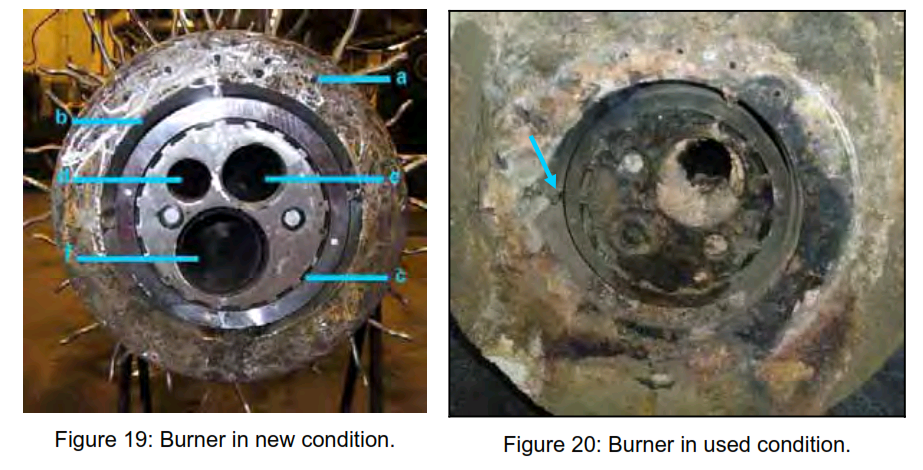
presented by
cand. Ing. Thomas Rüddenklau
Abstract
The following thesis is the first step to approach the subject of Snowman formation. In literature there cannot be found a lot of detailed analyses and coherences of those build-ups at the static cooler inlet. In general build-ups in the cement production often cause kiln shut downs with the result of additional cost. Fact is that every identification of a possible problem leading to loss of production means a prevention to reduce cost. Along a developed checklist a cement plant with Snowman formation was checked. Influences like e.g. the content of melting phase of the clinker, the air distribution at the static cooler inlet or the steadiness of raw meal and fuels feeding, which lead to this kind of production breakdown, are presented and discussed. Additionally, some analyses of a Snowman are presented and the relevant consequences for the checked plant have been drawn. These analyses show that the investigated Snowman is built by fritted clinker dust. Besides this some preventions are presented like a general chemical analysis of raw meal fed into the kiln, an improvement of air distribution at the static cooler inlet as well as an additional independent control cycle with a clinker-level measurement. These actions can help to improve the situation at the investigated cement plant and other cement plants with Snowman formation problems.
Introduction
Build ups are often the reason for kiln shut downs. Increased pressure losses or the different chemical compositions of intermediate products, give first indications. Very often salt compositions (e.g. alkali chlorides and sulfates) cause those undesired build ups, which can be found from the kiln inlet up to the cyclones of the preheater tower. A bypass system decreases those emissions by extracting parts of the gas streams from the kiln inlet. Those extracted gas streams are cooled and dedusted separately.
Another disturbing build up can be found at the discontinuous operating connection between kiln and cooler. There, especially at the static cooler inlet, build ups are formed which are called Snowmen because of there design. Apparently the causes are not indicated in sufficient time. These build ups cannot be predicted because of a lack of information about the reasons of formation. On the one hand chemical and mineralogical composition, grain size distribution and temperature of the burned material affect the physical clinker properties. From this point of view some evidences are desired for the behaviour of clinker at the grate coolers. On the other hand the cooler construction and the distribution of cooling air at the cooler inlet affect the clinker transport.
In this thesis the cement plant in Brevik, Norway, which had great problems with Snowman formations, was checked. For that, a useful checklist is developed and will be presented along the found facts of this cement plant. It will be shown that several influences combined with each other lead to Snowman formation. Luckily there was a chance to save a piece of an indicated Snowman formation. This Snowman sample will be analysed and discussed in detail. These information will show that this Snowman in particular is built by fritted clinker dust. For comparable reasons another cement plant, which is located at Burglengenfeld, Germany, was investigated. This cement plant is selected as one with almost no Snowman formations. The specific cooling air quantities in particular give useful information for comparisons.
This thesis is made at the HeidelbergCement Group in cooperation with the Clausthal University of Technology. Special thanks applies to the people from the cement plant in Brevik, Norway, the people from Heidelberg Technology Center (HTC-Germany) and the cooler manufacturers IKN Neustadt and Claudius Peters.
Principles
Clinker phases
Essentially cement clinker consists of tricalcium silicate (Alite), dicalcium silicate (Belite), tricalcium aluminate (Aluminate) and calcium aluminoferrite (Aluminoferrite). It is produced from a raw material mix which contains mainly calcium oxide (CaO), silicon dioxide (SiO2), aluminium oxide (Al2O3) and iron oxide (Fe2O3). A summary of the potential phase composition are shown in Table 1.
Table 1: Potential phase composition of German cement clinker [1].
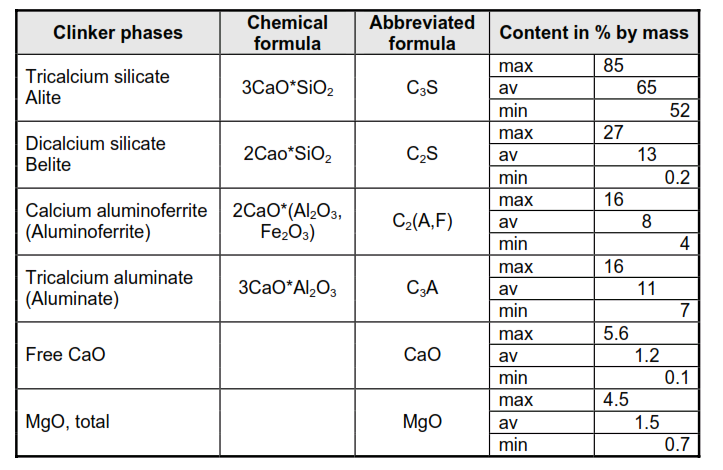
The raw material mix is fed into the kiln (see chapter Burning process). By increasing the temperature during the process the following reactions take place to form clinker phases (Figure 1) [2]:
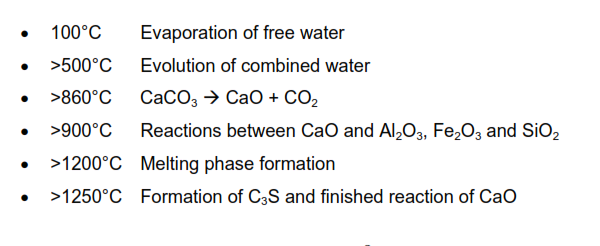
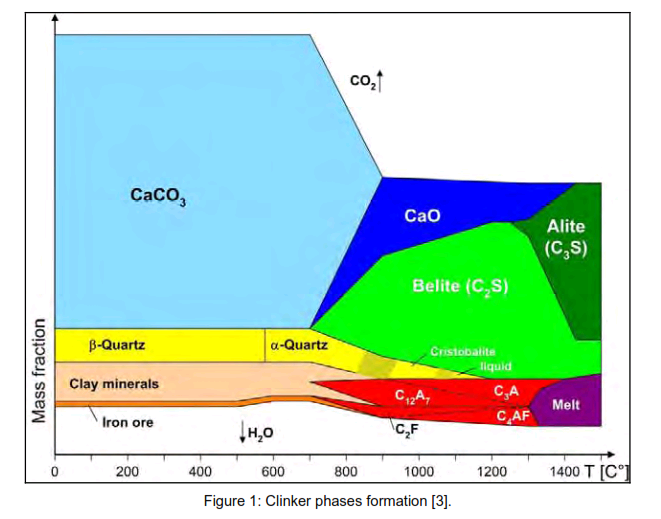
Calculations of the phase composition
The phase composition of a cement clinker can be calculated from the values of the chemical analyses according to R.H. Bogue. For a cement clinker of usual composition, which contains C3S, C2S, C3A and C4AF and has the AR >0.638, the following formulae can be used:
C3S = 4.071*CaO – 7.600*SiO2 – 6.718*Al2O3 – 1.430*Fe2O3
C2S = 2.867*SiO2 – 0.754* C3S
C3A = 2.670*Al2O3 – 1.692*Fe2O3
C4AF = 3.043 Fe2O3
These calculations do not reflect the reality but give a potential composition, which is used in practice. However the phase composition given by the calculation is only valid if the clinker melt is always in thermodynamic equilibrium with the solid clinker phases Alite and Belite. In practice this precondition is never fulfilled. Therefore the calculation of Bogue always gives too low values for the Alite and too high values for Belite content. But the difference between the calculated and the actual clinker composition can be determined by quantitative microscopic methods or by X-ray diffraction analysis. [1]

Other important moduli
The calculation of the Bogue potential clinker composition is descriptive but it does not give any impression of the contents of CaO in the clinker. Therefore the raw material and the clinker compositions are generally characterized by moduli in practice. These are called the lime saturation factor (LSF), the silica ratio (SR) and the alumina ratio (AR). Additionally, the degree of sulfatization (DS) is used. Table 2 shows potential values of German cement clinker for those moduli. [1]

Lime saturation factor (LSF)
The lime saturation factor shows the actual CaO content in the raw material mix or in cement clinker relative to the maximum CaO amount, which can be combined with the SiO2, Al2O3 and Fe2O3 under industrial burning and cooling conditions. It can be calculated as follows [1]:

Silica ratio (SR)
The silica ratio is the mass ratio of the silicon dioxide content relatively to the total of the aluminum and iron oxide contents. It describes the solid/liquid ratio in the sintering zone of the cement kiln. The following formula shows the mentioned relation [1]:

Alumina ratio (AR)
The alumina ratio gives information about the quantity of calcium aluminate to calcium aluminoferrite. It reflects the behaviour of the clinker melt. The following formula can be used for calculation [1]:

Degree of sulfatization (DS)
The degree of sulfatization shows the percentage of the alkalis, which are presented as alkali sulfates. It can be calculated as follows:

A degree of sulfatization of 100 % means that all the alkalis in the clinker are totally combined to alkali sulfate. If the degree of sulfatization is higher than 100 %, then there is a sulfur excess, which forms Ca-langbeinite (K2SO4*2CaSO4) and/or anhydrite (CaSO4) [1].
Burning process
At present there are two different techniques of clinker manufacturing; one is the dry and the other the wet process. For this thesis, only the dry process is relevant and will be described. In the fifties and early sixties two types of external preheaters were developed; a preheater with Lepol grate and a suspension preheater. Progressively the suspension preheaters predominate and are only important for this thesis [4].
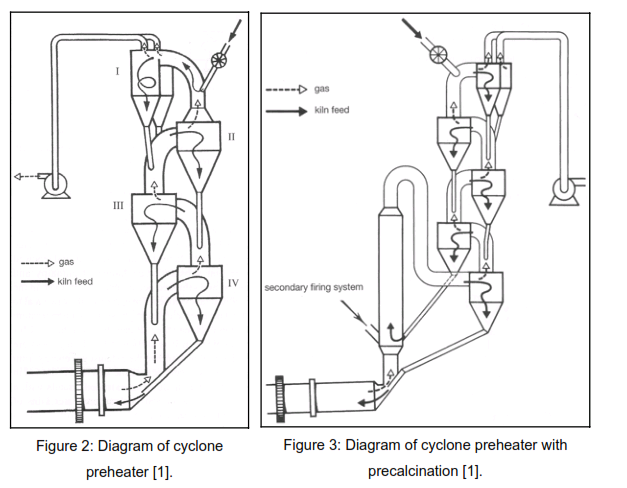
The suspension preheaters, also called cyclone preheaters, have a simple layout and several designs. The first system of this type was developed by Klöckner-Humboldt-Deutz. Several cyclones are arranged superposed and displaced sideways. They are connected and form the preheater tower. The first one consists of four cyclone stages (Figure 2), but newer kiln systems have up to six stages. The main task is to preheat the raw material. The exhaust gases from the rotary kiln pass through the cyclones from bottom to top. The dry raw material is added to the exhaust gases before the top cyclone stage, is separated from the gas and then drops back into the gas flow before the next cyclone stage. This process is repeated up to five times until the material is discharged from the last cyclone stage into the kiln.
Since 1970 those kiln systems got a new development, which is called precalcination. This means that the supply of fuel energy is divided into two firing systems. The new additional firing system takes place at the preheater (Figure 3). This means that the calcium carbonate
in the kiln feed is dissociated over 90 %, when it enters the kiln. The degree of dissociation of the kiln feed is between 40 – 50 % at conventional burning processes.
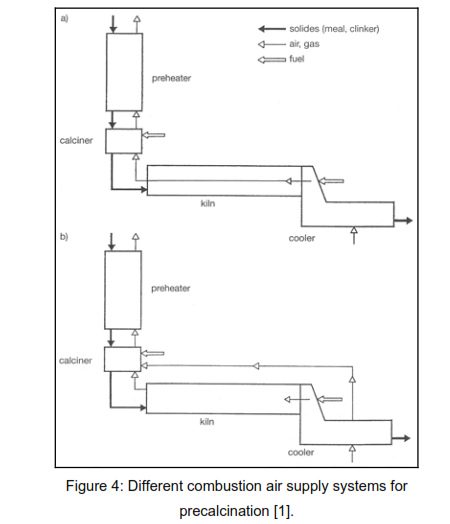
In the precalcining process the combustion air required for the firing system can be taken from two different ways (Figure 4). On the one hand, through the rotary kiln (a) and on the other hand directly from the clinker cooler through a special duct, which is called tertiary air duct (b). The connection of this duct can be located in two different positions. The first one is on top of the kiln head (connection between kiln and cooler) and the second is directly after the kiln head on top of the cooler enclosure.
Vaporizable constituents and its recirculating system
The hot kiln gas, which heats the kiln feed by counter-current flow, contains various gaseous or vapour compounds. These are formed from vaporized or disassociated constituents of the kiln feed and the fuel. These are mostly alkali, sulphur and chloride compounds as well as some trace elements like zinc, lead, chromium, cadmium, thallium, mercury and fluoride. The vapour compounds condense in the cooler parts of the kiln or in the preheater or in the downstream installations and deposit on the kiln feed and dust. If the fraction deposited on the kiln feed passes the hot zone of the kiln again and vaporizes, then internal circulations can be formed. The constituents are often carried out of the kiln and preheater area and collected in the gas cleaning system. These constituents are added to the raw meal again with the dust and go back to the kiln. This creates an external recirculating system (e.g. the green line in Figure 5). The internal and external recirculation can be reduced by removing part of the recirculating substances from the system e.g. by a bypass system.
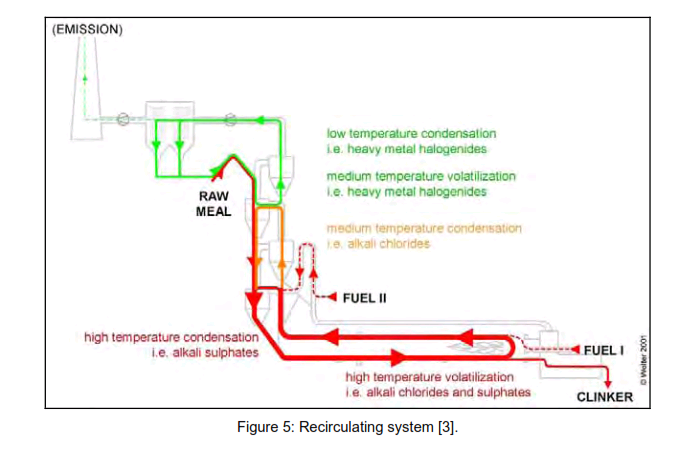
The most important recirculating substances are alkali sulphates and alkali chlorides, which can affect the operation of a cement kiln system. This recirculation system can be found at the high temperature part of the kiln system (red line). They can form an additional melt in the clinker, which influences the flow characteristics of the material in the kiln. [1]
Operation control measurements
The kiln operation is mostly monitored by several measurements:
Production rate [t/h]
Operating hours
Involuntary downtime hours
Total fuel rate [t/h]
Specific heat consumption [kcal/kg]
Proportion of fuel to precalciner / riser [%] Secondary air temperature [°C]
ID fan draft [mmH2O]
Preheater exhaust gas temperature [°C] O2 Kiln feed-end and exhaust gas [Vol.-%] Downcomer O2 [%]
Kiln feed-end material: – LoI [%]
Kiln drive power [kW]
There are also numerous other process parameters which should be logged. Those data are needed to observe trends, which may indicate problems and to provide necessary mean data for process analyses. Those factors are [2]:
Primary air tip velocity [m/sec]
Specific kiln volume loading [%]
Gas velocity in burning zone [m/sec]
Specific heat loading of burning zone [kcal/h per m² of effective burning zone cross-section area]
Cooler air [Nm³/h per m² grate area]
Cooler + primary air [Nm³ per kg clinker]
Temperature, pressure and oxygen profile of preheater NOx and CO in the waste gas
Clinker cooling
The cooling process influences the structure of the clinker, its mineralogical composition as well as the grind ability and in consequence the quality of the produced cement.
The speed of clinker cooling has an influence on the ratio of crystalline and melting phases in the clinker. During slow cooling almost all clinker components are formed of crystals, whereas fast cooling delays the formation of crystals and avoids the generation of the melting phase. A typical value of melting phase in clinkers from rotary kilns is in the range from 20 – 25 mass-%. Additional fast cooling prevents the crystal growing and has also an influence on the formation of the periclase crystals (MgOfree). The faster the cooling of clinker, the smaller the periclase crystals grow, which emerge by crystallization of the melting phase. A typical size of fast cooled clinker is in the range from 5 – 8 µm. Slow cooled ones have up to 60 µm large crystals [5].
It is reported that the best clinker is obtained by cooling slowly to 1250 °C followed by rapid cooling [4]. A summary of the effects of cooling rate on the clinker phase and their properties can be seen in Figure 6.
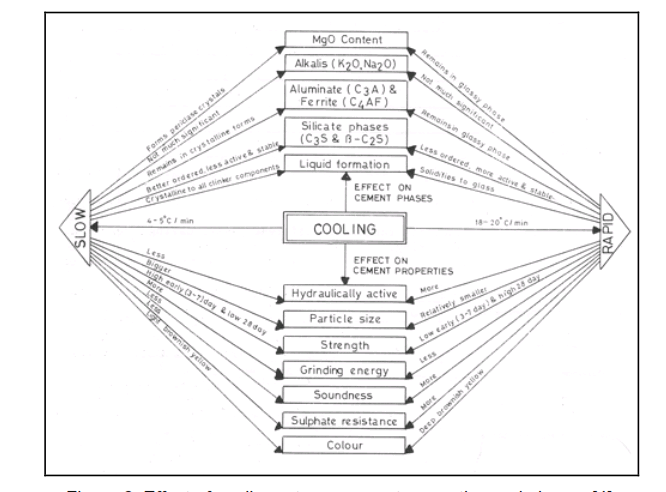
Figure 6: Effect of cooling rate on cement properties and phases [4].
Clinker cooler types
Clinker coolers can be found basically in three different types. They are built as grate, rotary or planetary coolers (Figure 7). The coolers differ mainly in the type of heat transfer, the length and the design of pre-cooling zone (see the dot and dash line in Figure 7), the clinker inlet temperature and the controllability.
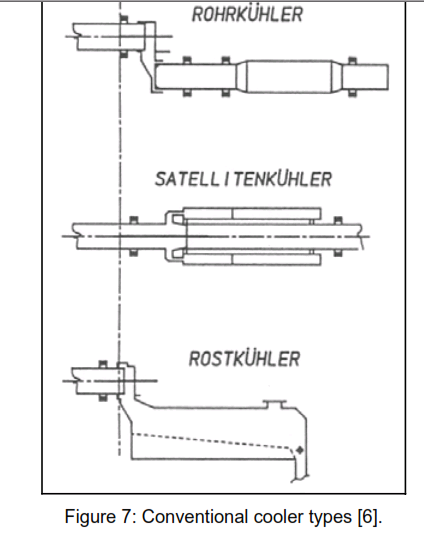
The rotary coolers (Rohrkühler) are the older ones. The heat transfer of the hot clinker to the cooling air occurs by counter current flow. The pre-cooling zone is longer than the one from the grate coolers (Rostkühler), which decreases the clinker inlet temperature (1400 –> 1200 °C). The rotary cooler has an independent adjustable rotation speed from the rotary kiln. A summary of essential technology data of rotary coolers can be found in Table 3.
Table 3: Essential technical data of rotary coolers [6].

The planetary coolers (Satellitenkühler) consist of nine to eleven cooling tubes attached around the perimeter of the kiln tube. The heat transfer also takes place by counter current flow like the rotary coolers. This cooler cannot be adjusted. The specific cooling air quantity is identical with the amount of combustion air. Caused by a longer pre-cooling zone the clinker inlet temperature is lower compared to rotary coolers. Table 4 shows essential technology data for this type of cooler.
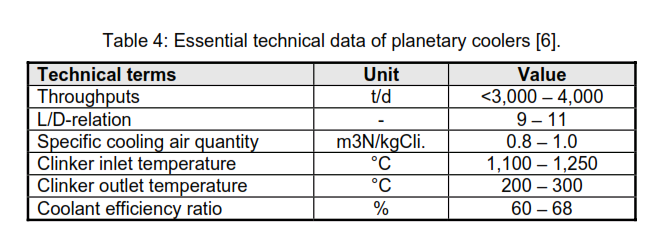
A grate cooler is nowadays the usual cooler type. In this cooler the clinker bed is transported on a grate, which is cooled by transverse flow of air. This type of cooler requires more cooling air than is needed for the combustion. The cooler exhaust air can be used e.g. for drying the raw material. Table 5 presents the relevant information about the technology of grate coolers.
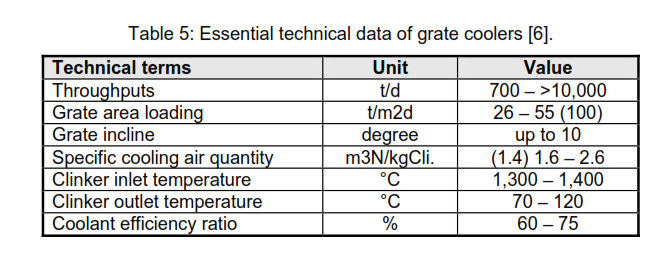
Principle design and process technology features of modern grate coolers
Fixed inlet areas
The fixed inlet of a cooler is the most important interface between the rotary kiln discharge and the clinker cooler. Almost all cooler manufacturers use a fixed inlet area with direct aeration to improve the thermal efficiency of the cooler system and to increase the availability of the grate plates in the hot zone. But the static inlet also increases the risk of the formation of a “Snowman”, which is further strengthened by using more and more secondary fuels [7].
Grate plate development
Modern grate plates and their systems enhance the grate resistance for improving the air distribution and its thermal efficiency of both aeration systems (air beam and chamber). The new developed plates raise the service life of mechanical parts and minimize their wear. Additionally they achieve a constant grate resistance over a longer operating time and reduce the grate riddling by having constant, narrow gaps and slots [7].
Side sealing
New developments of grate seals minimize the gaps during thermal expansion of the grate surface. Very long service lives are achieved by hardening the surface of the moving parts of a plate. This prevents air channelling at the edges of a clinker cooler [7].
Cooler drive
The hydraulic cylinder drive is developed continuously. The stroke lengths and the cylinder speeds are optimized to an effective conveying and minimization of wear (fewer thrusts) [7].
Clinker crusher
A modern cooler requires a roll crusher. This type of crusher is in fact more expensive than a hammer crusher but the maintenance and spare-parts costs are very low. The dust load at the end of a cooler is lower by using a roll crusher. This type of crusher deals with very large pieces of coating from the kiln, which avoids unplanned kiln shut downs [7].
Improvement of thermal efficiency
By using a specific and controlled direct aeration of the static inlet, the efficiency of a cooler can be improved significantly. The air and material distribution play a decisive role. The main goals are that the clinker is optimally cooled down and gets the best heat recuperation. In other words a good material distribution at the start of the grate, maintains a constant clinker bed with a depth of about 500 to 900 mm over the entire grate area. This is achieved by a static grate or special distribution grates for large widths. Additionally, a partition wall between the recuperation zone and the cooling area minimizes the heat radiation loss and assists the heat exchange [7].
Material discharge system
The discharge of grate riddling can be solved in different ways. One is the traditional hopper arrangement with double flap valves or the other the level-controlled slides with a drag chain to remove the material. Furthermore coolers with small gaps reduce the grate riddling.
The newest development is a cooler design without grate riddling. At this type of cooler, known as a reciprocating beam cooler, the transport mechanism is separated from the cooling mechanism. This means that the aeration base has no moving parts and is protected by a stationary layer of clinker [7].
Grate support system
The internal roller or axle support systems are used for supporting the grate or moving frame. The design and material of these systems is improved to reduce the wear [7].
Cooler control system
The following measuring and control loops can be used for an automatic process control of a clinker cooler:
Cooling air volume flow
Chamber pressure / grate thrust rate
Kiln hood pressure
Grate plate temperature
Secondary / tertiary air temperature
Exhaust air temperature
Normally the grate speed is controlled by the pressure in the first air chamber or by a combination of several initial air chambers. New developments like level radar, which measures the clinker bed depth at the inlet of the cooler directly, can be very useful for the control of the grate speed [7].
Cooling air fans
In general the cooling air comes from radial fans with double bearings. By using fans operating at constant speed with small changes in air quantity the air volume is controlled by a vane controller with an actuating mechanism. Only fans with large control reserves (e.g. at the inlet area) are operating with frequency-controlled motors. The first fans indicate a rotational speed of over 2000 rpm due to the high pressures of 80 – 130 mbar [7].
Process interrelationships – trend curves
The following trend curves show the qualitative coherence between the described process parameters. The quantitative coherence and the wave shape are not taken into account. For simplification all curves are drawn linear to get an impression for the existing interdependency [8].
Table 6: Clinker capacity – clinker exit temperature – cooling air quantity [8].
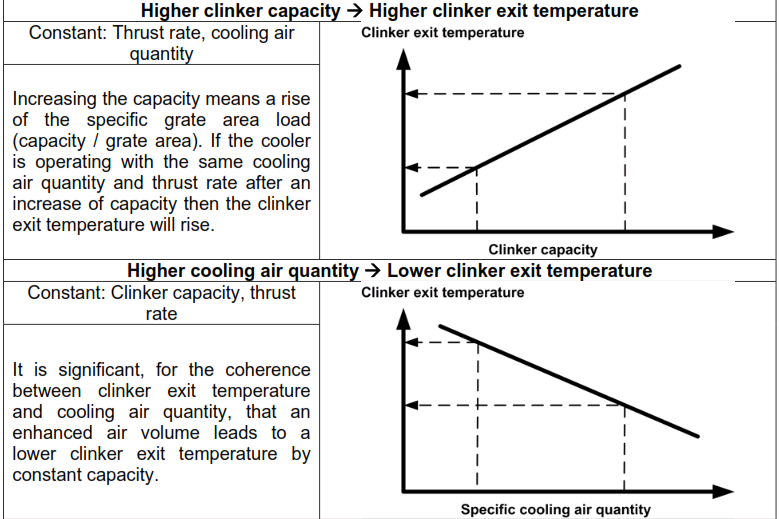
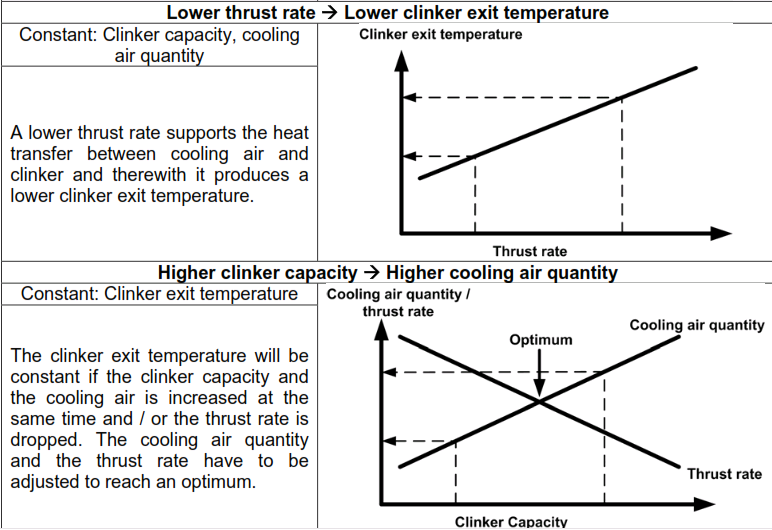
The main statement is that an optimal adjustment of cooling air quantity and thrust rate is preconditioned for a low clinker exit temperature.
Table 7:Specific cooling air quantity – secondary air temperature – cooler efficiency [8].
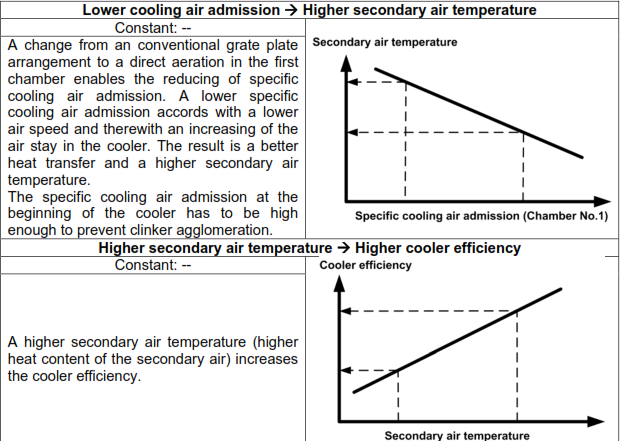
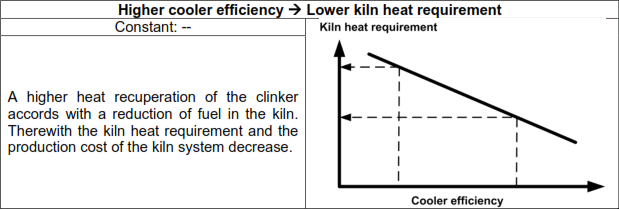
The main statement is that the cooling air admission at the beginning of a cooler affects essentially the recuperation efficiency of the cooler.
Table 8: Clinker bed level – thrust rate/time of stay – clinker exit temperature – wear [8].
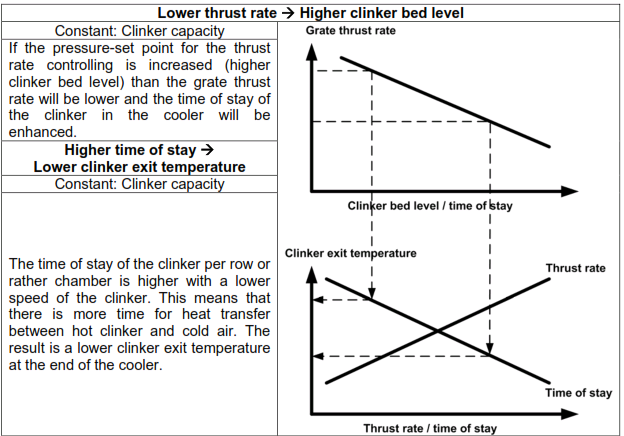
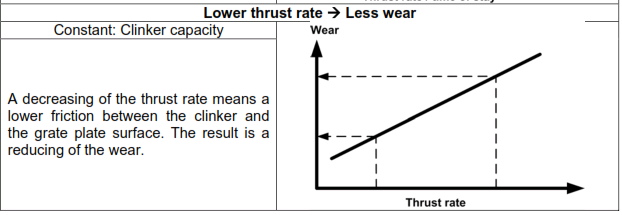
The main statement is that a lower thrust rate affects a higher clinker bed level and a higher time of stay of the clinker in the cooler. Furthermore the grate plate wear is lower by having a lower thrust rate standard.
Table 9:Clinker bed level – clinker exit temperature – cooler efficiency – power requirement[8].
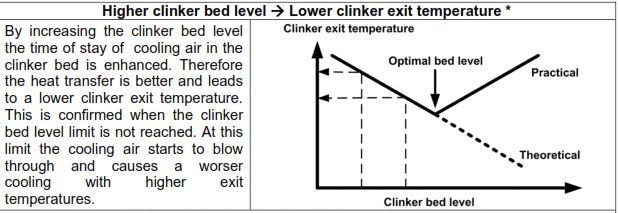
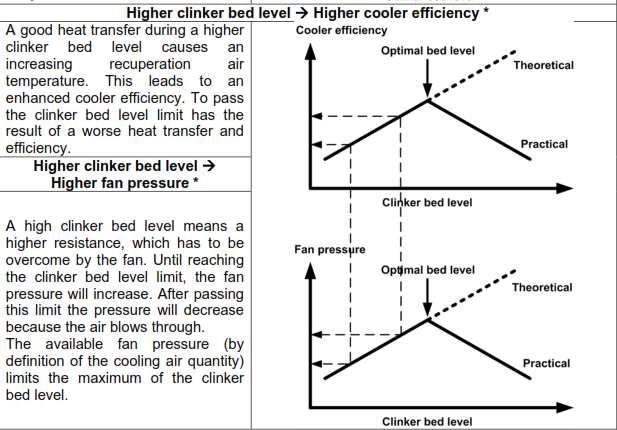
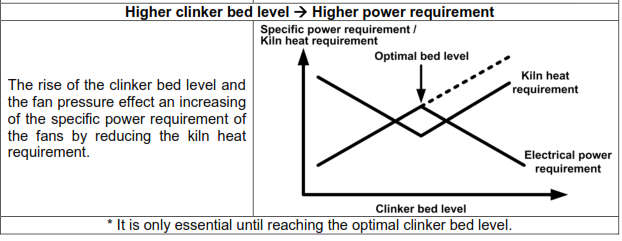
The main statement is that clinker bed level optimizing decreases the operating expenses.
Table 10: Cooling air quantity – thrust rate – exhaust air quantity – exhaust air temperature [8].
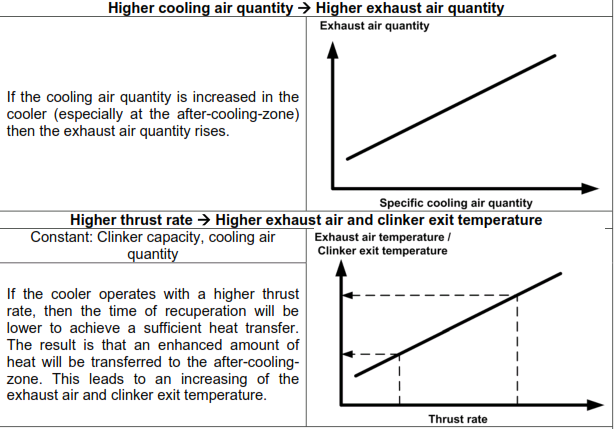
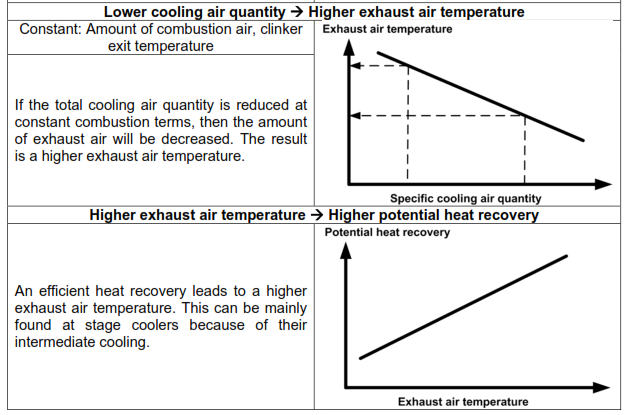
The main statement is that a higher thrust rate standard increases the heat losses of the cooler, which means that clinker exit and cooler exhaust air temperature rises.
Red River
The “Red River” is a phenomenon in the cooler. Distinctive for it is a narrow stream of fine clinker which appears far down in the cooler at higher temperatures than the neighboured clinker. This narrow stream is often red hot (hence the name). Fine and coarse clinker will be partly segregated in the kiln and fall separated to the right/left side of the static inlet. The fine clinker falls on the kiln load side and the coarse clinker on the other one. If, additional to the segregation, a clinker bed with unilateral or bilateral slope is formed on the static inlet, the fine clinker slides down the slope to the side (Figure 8).
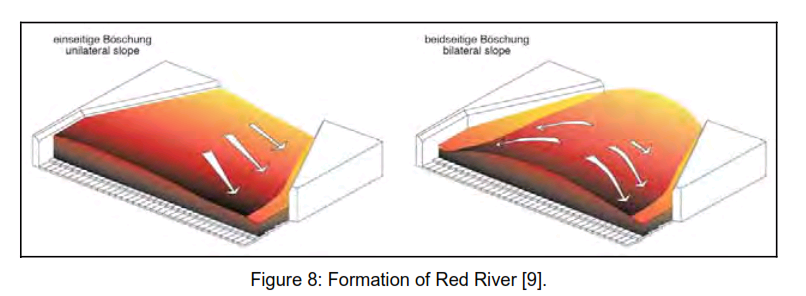
The segregation and slope, not inclined in clinker flow direction, are the reasons for “Red River”. Furthermore a “Red River” can be caused by a “Snowman” because of the disturbance of aeration at the static inlet in the cooler. A fine clinker has a higher resistance to the airflow than the coarse clinker, so the cooling air takes the path of least resistance, which intensifies the “Red River” formation. Figure 9 shows the pressure losses of various clinker sizes as a function of free air velocity. It can be seen that the particle size has a great influence on air distribution, which can be described by pressure losses [10].
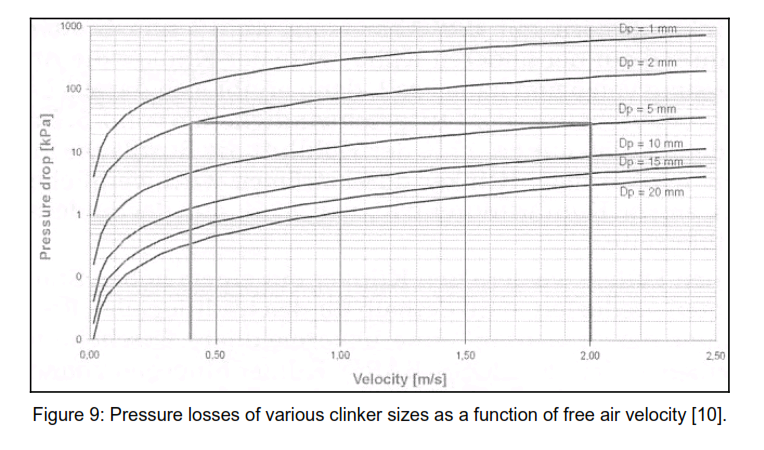
Snowman
Another phenomenon in the cooler is the formation of a “Snowman”. A Snowman (SM) is a type of build up formed in the static inlet. In general a snowman is caused by [9]:
fine and sticky clinker
fall of coating from the kiln.
A sticky clinker occurs when the content of the melting phase or the kiln temperature is too high. In the one case the melting phase works as a binder and bonds the clinker together. In the other case, fall of coating, a big lump stays in the cooler inlet without transport. The surface of the big lump means an additional free area. Those formed platforms are the base where a snowman can grow (Figure 10).
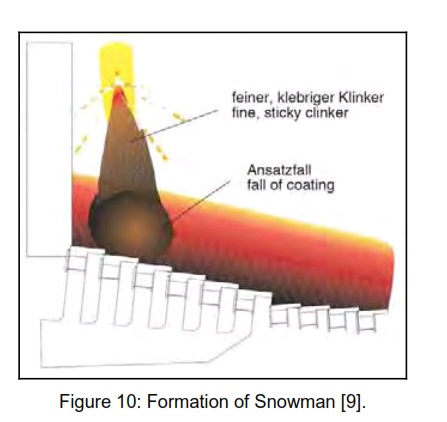
These big lumps cannot be cooled down. They store a lot of heat and disturb the aeration. Figure 11 presents the non-steady state cooling of clinker for a number of different clinker sizes as a function of time. It shows that it is physically impossible to cool large clinker particles (> 100 mm) to an acceptable temperature within a reasonable retention time of 20 min, which is typical for grate coolers [10].
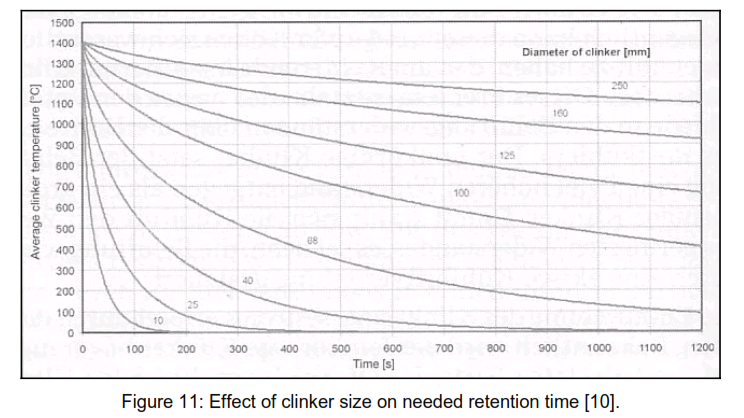
Clinker build ups at the static inlet of the cooler are mainly formed at clinker temperatures over 1250 °C in the kiln outlet [11].
The following checklist was made before visiting the cement plant Brevik in Norway. It was the first step to approach the Snowman phenomenon.
Checklist
This general checklist is written in keywords to shorten the thesis. A detailed explanation is given with the example of the cement plant in Brevik, Norway. The checklist is divided into three parts. The first one takes a look into the material data, the second one describes the process data and the last one shows other available data. All data show possible reasons for Snowman formation. Later on this checklist will be introduced by means of visiting the cement plant in Brevik, Norway.
Part 1 (Material data)
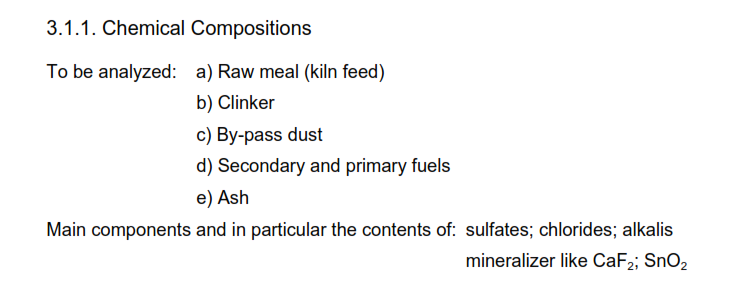
Clinker Mineralogy
Focusing on: liquid phase; CaOfree; MgOfree; oxidizing vs. reducing burning conditions, homogeneity.
Moduli
LSF; AR; SR; SD; Melt content; Sodium equivalent
Clinker
Grain size distribution (from cooler inlet; in front of the crusher) Segregation of the falling clinker into the cooler inlet
(Stickiness-check)
Liter-weight / density / porosity
Mechanical properties
Size distribution
Hot stage microscope
liquid phase vs. adhesion
Part 2 (Process data)
Feeding system

Kiln
Type of fuels
Temperature of: – flame (especially peaks) – secondary and tertiary air
Design of the flame
Coal fineness
NOx-values (Over-burning)
Zone length (especially pre-cooling and sintering zone)
Electrical power consumption (peaks?)
Rotary kiln speed
Places of Build-ups caused by dust
Dust content in the secondary air and handling system
Gas velocity at the kiln outlet
Cooler
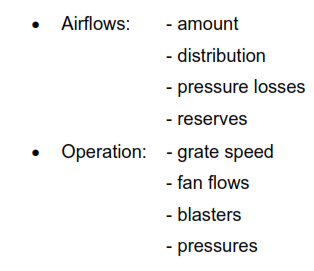
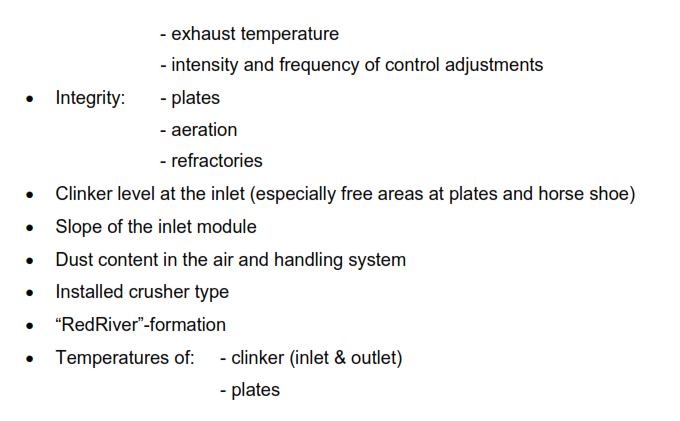
Part 3 (Other data)
Snowman type
“mushroom”-formation (fast growing on a small area, not moveable)
“sugar loaf”-formation (fritted dust, moveable)
“bridges”-formation (connection between each side or corner of refractory walls)
Visual checks
– Glowing clinker after cooler outlet amount of crushed clinker (extreme grain sizes)
– “Bubbling” at the surface of the clinker bed in the cooler (“BlowThrough” indication at high clinker levels)
– Surface colour of the clinker flow
Conclusions
Snowman
The Snowman analyses show that the investigated Snowman of Brevik is built by fritted clinker dust and small clinker particles < 800 µm. The clinker phases have no content of chlorides and a low content of sulfates. This fact is caused by passing the sintering zone. In the sintering zone the chlorides vaporize totally. The duration of dwell was not long enough to vaporize the sulfates completely, so a lower content of sulfates can be found in the Snowman than in the clinker. The very low free lime content shows that the material of the Snowman is burnt under higher temperatures as usual. This fact is also underlined by the measured secondary air temperature from the process data. It is found that the secondary air temperature has two peaks to higher temperatures, caused by too much fuel feeding. Furthermore the clinker phases of the Snowman have higher contents of C2S and C4AF and also a lower content of the C3A phase. This fact can be the result of fluctuations in the raw meal composition or caused by the uneven energy input which also leads to inhomogeneities. Possible fluctuations in the raw meal chemistry cannot be checked. As mentioned the two raw meal checkpoints for the plant analyses are both before the 25,000 tons raw meal silo. There are no general analyses of the kiln feed which can help to prevent those potential fluctuations. Besides this the most surprising fact is that the content of liquid phase is lower than expected. Because of a very high temperature in the process and a very high dust content, which can be seen at the kiln head, this type of Snowman is formed. This shows that a Snowman formation can be formed although the melting phase content is very low. A possible formation of this type of Snowman is described in the next paragraph.
Hypothesis of Snowman formation
During the time period when the analysed Snowman occurred, there seemed to be a coating fall according to examination of the process data. Big lumps fall from the kiln into the cooler inlet and stay at the plates of the static part. As mentioned before this leads to a platform where a Snowman can grow. In Figure 39 the proposed clinker dust cycle is shown.
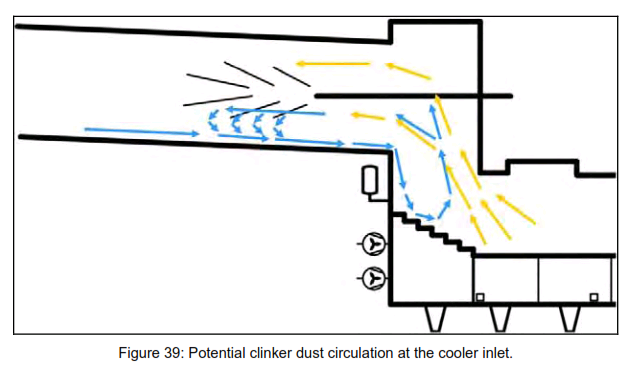
Figure 39: Potential clinker dust circulation at the cooler inlet.
Dust from the cooler streams into the kiln with the secondary air, marked by yellow arrows. This air is rich on clinker dust and streams under the flame. With additional clinker dust from the kiln and the jet air pressure differences under the flame, the clinker dust air is deflected, which is marked by the blue arrows. Furthermore this deflection is probably intensified by the broken spacer of the burner pipe. The air under the flame streams back to the cooler, passes the surface of the static inlet and streams back into the kiln with the secondary air. On the free area as a result of coating fall, the clinker dust can deposit on this lump especially during the deflection at the cooler inlet. With the indicated high temperature combined with the very bad aeration in the area of the static inlet this Snowman is formed. Additionally, this type of Snowman formation is also underlined by the fact that high gas velocities (8 m/s) exist at the static inlet. These high gas velocities are caused by the small kiln head. Moreover the high dust content in the secondary air comes from the high sulfate content. The calculation of the moduli shows a degree of sulfatization over 100, which means a sulfur excess. Free sulfates makes the clinker granules porous and brittle. These dust particles are easily carried away from the clinker surface with the high gas velocity.
In addition those glowing dust clouds are well known from nature and can be compared to the phenomenon at the cooler inlet (see the next paragraph “7.3 Comparable natural phenomenon”).
Comparable natural phenomenon
In nature glowing dust clouds are called Ignimbrite. Geologists also call them pyroclastic flow deposits. They are formed during volcanic eruptions. Generally, three different ways of formations can be found in nature (Figure 40).
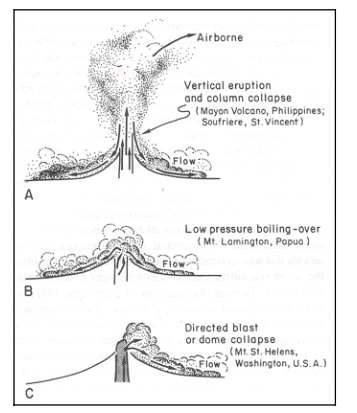
Figure 40: Some ways the pyroclastic flows can originate [16].
The first one is a vertical eruption and column collapse, the second one a low pressure boiling over and the third one a directed blast or dome collapse. All of them produce a lava stream combined with glowing dust clouds. The glowing dust clouds consist of particles with a size of < 2 mm. Those streams have high velocities from 14 up to 230 km/h under temperatures around 500 – 650 °C and up to 850 °C. The dust content of those clouds varies around 1 g/cm³. Figure 41 shows such an ignimbrite in detail.
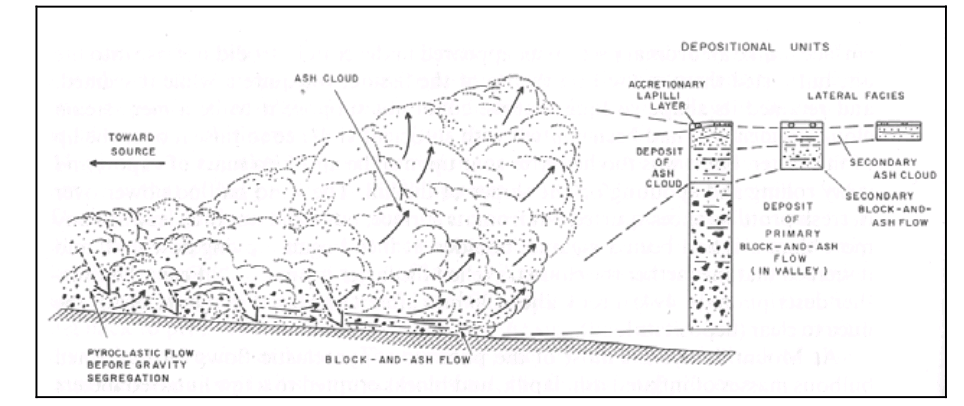
Figure 41: Diagram showing development of block and ash flow [16].
It can be seen that the structure of a Ignimbrite is caused by dense segregation. The particles with a higher density and a bigger size can be found after cooling down at the bottom layers. In contrast to the particles with a lower density, they deposit more at the top of the rock. This segregation leads to the typical structure of an Ignimbrite. Furthermore under high temperatures a plastic deformation affects the structure. Some dust particles are welded together which can be seen in Figure 42. Lines separate the different layers in this Ignimbrite from Gran Canaria.
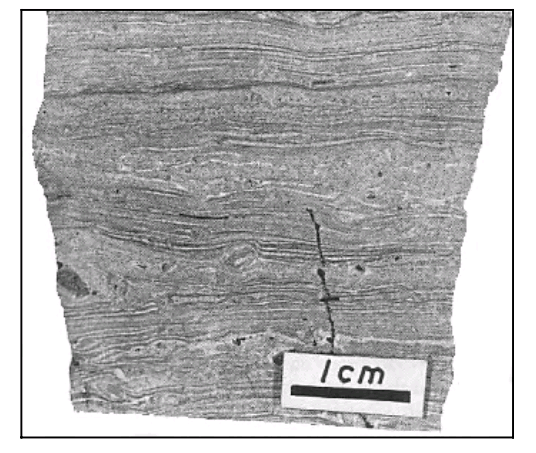
Figure 42: Strongly welded pantelleritic ignimbrite from Gran Canaria [16].
Emphasis of the important items of the Checklist
At Brevik several influences are detected. The fuel feeding, especially of animal meal, indicates some problems which leads to an uneven energy input. In addition the burner was in bad shape because of a broken spacer and closed air jet pipes. The process data indicates a periodical over heating of the kiln. Furthermore the fans of the static cooler inlet operate almost on maximum air volume to prevent a potential Snowman formation, but with an extremely disturbed distribution of cooling air this prevention has no effect. Some plates of the static inlet are overheated and show plastic deformation. Possibly the high gas velocity and the high dust content in the area of the kiln hood are the basic conditions of the Snowman formation. The high content of sulfates from the raw meal leads to porous clinker. Combined with the overheating and high gas velocity the recuperation air becomes rich on dust. Finally, several influences make a Snowman formation possible. A suggested emphasis of the important items of the developed checklist are mentioned below.
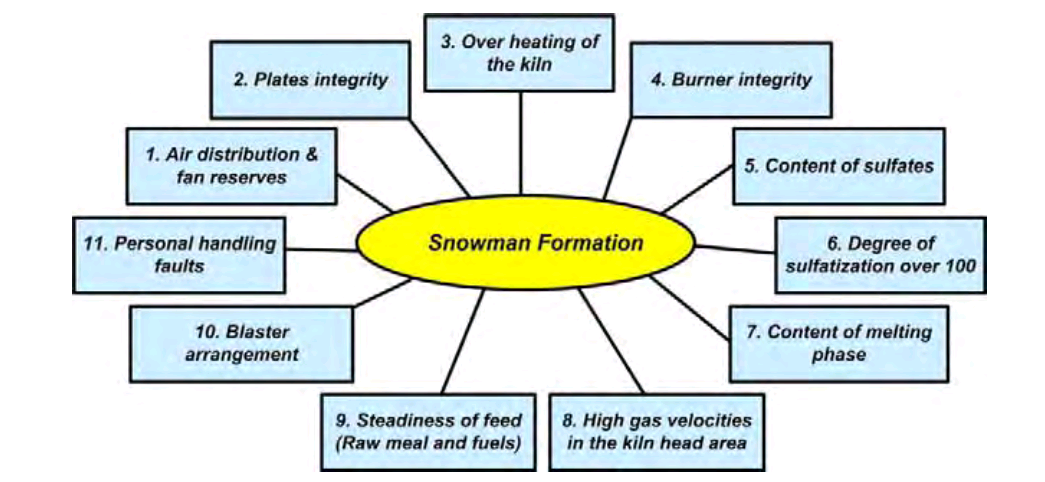
Figure 43: Emphasis of the important items of the checklist.